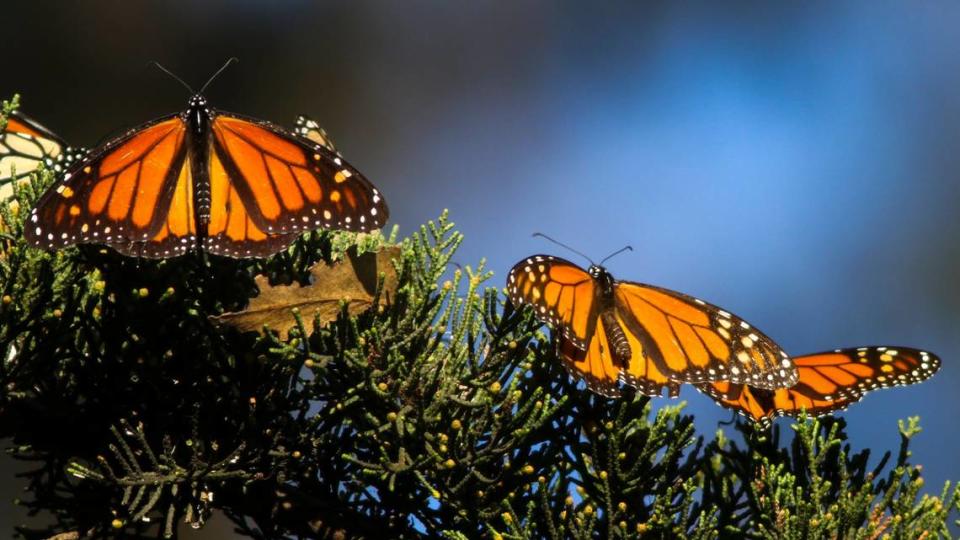Monarch butterflies are fluttering along California coast. Here’s where you can see them
Monarch butterflies are fluttering along California’s coastal areas as a part of their annual winter migration — and there are a few spots where you can see them in action.
According to Western Monarch Count, a volunteer community of scientists that tracks western monarch butterflies along the Pacific Ocean coast from Mendocino to Northern Baja, Mexico, the orange-and-black insects are in the midst of their overwintering season, which runs from October to March.
Overwintering is what happens when the monarchs leave behind colder northern climates and head south in search of warmth, the U.S. Forest Service said on its website.
Some butterflies fly as far as 3,000 miles to reach their winter homes, the Forest Service said.
“California is the only place in the country that regularly hosts the awe-inspiring sight of thousands of monarchs gathered for winter,” Western Monarch Count said. “These days, most of California’s monarchs cluster in groves of nonnative blue gum eucalyptus, although they also use native trees such as Monterey pine, Monterey cypress, sycamore, and redwood.”
See our interactive map to find the best butterfly viewing spot near you.
Where can I see monarch butterflies?
According to Visit California, Pismo Beach on the Central Coast and Pacific Grove in Monterey County are among the most popular destinations for monarch butterfly watchers.
There are several other spots to view the butterflies, the site said, including Fiscalini Ranch Preserve in Cambria, Coronado Butterfly Preserve in Goleta, Ellwood Mesa Open Space in Goleta and Point Mugu State Park in Malibu.
Pismo Beach
Pismo Beach Monarch Butterfly Grove, 400 South Dolliver St. in Pismo Beach, hosts scores of monarch butterflies each year.
As of Nov. 2, more than 8,000 butterflies had been counted at the site.
Located off Highway 1 in San Luis Obispo County, the coastal grove of eucalyptus trees is free to visit.

Pacific Grove
Pacific Grove Monarch Sanctuary, 250 Ridge Road in Pacific Grove, is the largest spot for monarchs to overwinter in Monterey County, according to its website.
As of Nov. 10, more than 7,600 butterflies had been spotted at the sanctuary.
There’s no admission fee and parking is free.
Santa Cruz
Monarch butterflies are known to gather at a particular eucalyptus grove at Natural Bridges State Beach in Santa Cruz, 2531 West Cliff Drive, in Santa Cruz.
This is because the grove is in a canyon that protects the insects from coastal winds, according to the Santa Cruz website. The trees’ leaves help keep sunlight in and their flowers are a source of food.
Parking is $10.
Bodega Bay
Bodega Dunes Campground, 2485 Highway 1, Bodega Bay, is a good place to spot monarchs, according to Visit California.
Parking costs $8.
How you can help save the monarch butterfly
According to the California Department of Fish and Wildlife, monarch butterflies are slated to be listed as endangered under the federal Endangered Species Act in 2024.
There are several things people can do to help protect monarch butterflies, according to the Xerces Society for Invertebrate Conservation.
The nonprofit organization suggests the following:
Adopt an overwintering site and become an advocate for the site’s protection and management.
Plant native California flowers that bloom in the early spring (February through April) to provide critical food for the monarchs.
Plant native milkweed including woollypod, California, heartleaf, narrowleaf and showy milkweed plants.
Seek out non-chemical options to prevent and manage pests in your garden and landscaping. Pesticides, herbicides and insecticides can all kill monarch butterflies.
Report all monarch adult, caterpillar, egg, nectaring and milkweed sightings to the Western Monarch Milkweed Mapper.
Use the hashtag #SaveWesternMonarchs on Facebook, Twitter and Instagram to raise awareness.
What do you want to know about life in Sacramento? Ask our service journalism team your top-of-mind questions in the module below or email servicejournalists@sacbee.com.

